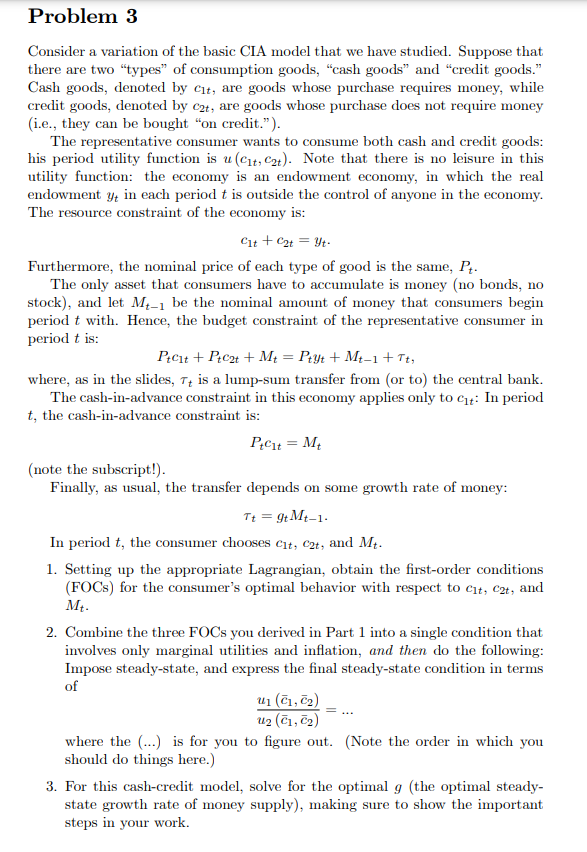Answered step by step
Verified Expert Solution
Question
1 Approved Answer
Problem 3 Consider a variation of the basic CIA model that we have studied. Suppose that there are two types of consumption goods, cash

Problem 3 Consider a variation of the basic CIA model that we have studied. Suppose that there are two "types" of consumption goods, "cash goods" and "credit goods." Cash goods, denoted by Ct, are goods whose purchase requires money, while credit goods, denoted by c2t, are goods whose purchase does not require money (i.e., they can be bought "on credit."). The representative consumer wants to consume both cash and credit goods: his period utility function is u (C1, C2t). Note that there is no leisure in this utility function: the economy is an endowment economy, in which the real endowment y in each period t is outside the control of anyone in the economy. The resource constraint of the economy is: C1t + C2t = Yt. Furthermore, the nominal price of each type of good is the same, Pt. The only asset that consumers have to accumulate is money (no bonds, no stock), and let M-1 be the nominal amount of money that consumers begin period t with. Hence, the budget constraint of the representative consumer in period t is: Ptct + Ptc2t + M = Ptyt + Mt-1 + Tt, where, as in the slides, 7 is a lump-sum transfer from (or to) the central bank. The cash-in-advance constraint in this economy applies only to Ct: In period t, the cash-in-advance constraint is: PtCt = Mt (note the subscript!). Finally, as usual, the transfer depends on some growth rate of money: Tt = 9t Mt-1. In period t, the consumer chooses Cit, C2t, and Mt. 1. Setting up the appropriate Lagrangian, obtain the first-order conditions (FOCs) for the consumer's optimal behavior with respect to cit, C2t, and Mt. 2. Combine the three FOCs you derived in Part 1 into a single condition that involves only marginal utilities and inflation, and then do the following: Impose steady-state, and express the final steady-state condition in terms of u (C1, C) U2 (C1, C2) = ... where the (...) is for you to figure out. (Note the order in which you should do things here.) 3. For this cash-credit model, solve for the optimal g (the optimal steady- state growth rate of money supply), making sure to show the important steps in your work.
Step by Step Solution
There are 3 Steps involved in it
Step: 1
Here are my responses 1 FOCs u1c1tc2t t 0 u2c1tc2t tPt 0 t1gt t1 0 2 Com...
Get Instant Access to Expert-Tailored Solutions
See step-by-step solutions with expert insights and AI powered tools for academic success
Step: 2

Step: 3

Ace Your Homework with AI
Get the answers you need in no time with our AI-driven, step-by-step assistance
Get Started


